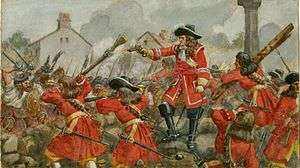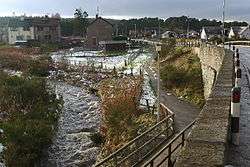Alexander Cannon
| Alexander Cannon | |
|---|---|
| Born |
1640 Galloway Scotland |
| Died | after 1708[1] |
| Allegiance |
Jacobite |
| Service/ | Infantry and Dragoons |
| Rank | Major general |
| Unit |
2nd English Regiment, Scots Brigade[lower-alpha 1] Queen Consort's Regiment of Light Dragoons Jacobite Army |
| Battles/wars |
Glorious Revolution 1688 1689-92 Jacobite Rising Battle of Killiecrankie Battle of Dunkeld Battle of Cromdale |
Alexander Cannon or Canan (fl. late 17th century) commanded regiments in the service of William of Orange and James II. He remained loyal to James after the 1688 Glorious Revolution and was appointed Major-General of Jacobite forces in Scotland after the death of Viscount Dundee in July 1689. He was replaced as commander by Thomas Buchan in early 1690 and remained in Scotland as his subordinate until provided with a safe passage to France in 1692. Little is known of his later career but he was still in Jacobite service in 1708.
Career
.jpg)
A Lowland Scot from Galloway, Cannon spent much of his career in the Scots Brigade, a unit in Dutch service under William of Orange; despite the name, for much of this period it contained three English and three Scottish regiments.[lower-alpha 2][2] In July 1680, he became Colonel of one of the English regiments [3] and went with it in 1685 when the Brigade was sent to help James II suppress the Monmouth rebellion. The revolt quickly collapsed and the Brigade returned to the Netherlands without seeing action but Cannon remained; in August 1685, he was appointed Lt-Colonel of the newly formed Queen Consort's Light Dragoons, the Duke of Somerset filling the largely ceremonial post of Colonel.[lower-alpha 3][4]
In August 1687, Cannon succeeded Somerset as Colonel when the Duke fell from favour and was with James when William landed at Torbay on 5 November 1688 in the invasion known as the Glorious Revolution. The Royal Army assembled on Salisbury Plain to block an advance on London but many now changed sides including the majority of the Queen Consort's Regiment who followed Cannon's deputy Lt-Colonel Richard Leveson into William's camp. Cannon and his own troop remained with James as he retreated to London and on 31 December 1688, William appointed Leveson as Colonel in his place; and as was customary, the regiment now became Leveson's Dragoons.[lower-alpha 4][5]
Role in First Jacobite Rising
Cannon next appears as part of the Jacobite forces landed in Ireland in March 1689 to support the War in Ireland and their main focus. The Scottish rising was dependent on Irish support which became more difficult after the so-called Battle of Loup Hill in May.[lower-alpha 5] This resulted in the loss of Kintyre which had allowed the Scottish Jacobites to be resupplied using small boats from County Antrim rather than requiring access to a port.[lower-alpha 6][6]
On 27 June 1689, the Scottish commander Dundee wrote to the Earl of Melfort in Ireland asking for 3,000 – 5,000 troops and munitions of various kinds.[7] However, this was impacted by the factional struggle between Jacobite Compounders and Non-Compounders who were reluctant to divert resources needed in Ireland.[lower-alpha 7][8] The Non-Compounders also sought to replace Dundee with their own nominee; the first choice was the experienced Scottish soldier and Catholic Thomas Buchan but he was needed for the siege of Derry.[9]
Instead, Cannon and 300 men were ferried across the Irish Sea in small boats, landing at Duart on 21 July and reaching Blair Castle on 26 July in time for the Battle of Killiecrankie. Cannon took command after Dundee's death but contemporaries like Lochiel considered him a poor and unimaginative leader, handicapped by his unfamiliarity with Highland military customs.[10] Lochiel later claimed he also spent much of his time drinking with Lord Dunfermline; even if true, heavy drinking was hardly unusual in this period.[11]

Regardless of Cannon's leadership qualities, Killiecrankie was a stunning victory that did not change the strategic position; no letters from Cannon survive but in February 1690 Buchan and Lochiel mirrored Dundee's letter of June 1689 by requesting money, weapons plus 4,000 foot and 1,000 cavalry.[12] These demands were unrealistic as was the suggestion that James' illegitimate son the Duke of Berwick be appointed leader; this reflected the absence of any senior Scottish regional magnates.[13] Obtaining supplies still required access to a major port; since the Royal Navy had re-established control over the Irish Sea by breaking the Siege of Derry, Cannon headed for Aberdeenshire, an area dominated by the Catholic Gordons and an Episcopalian and Royalist stronghold since the 1630s.[14]

While some members of the Scottish Parliament panicked, General Hugh Mackay did not, despite claims by Sir Walter Scott that the Williamite government was saved only by Dundee's death.[15] An advance on Edinburgh was blocked by Stirling Castle which the Jacobites failed to capture in 1746 with considerably better siege equipment and lack of cavalry made them vulnerable in the open. Even experienced leaders like Dundee found it hard to keep a Highland army in the field, while the increase in numbers after Killiecrankie to 4,000 – 5,000 did not necessarily improve fighting capacity. Supplying a force of this size was far more difficult and the new recruits included many like the MacGregors who saw it primarily as an opportunity for raiding.[16]
Once Cannon was prevented from reaching Aberdeen, his options were limited; the Battle of Dunkeld on 21 August makes little strategic sense since Highland tactics were unsuited to urban warfare and they were repulsed with heavy losses. The Jacobite army now effectively disbanded itself by going home while Cannon and his remaining Irish troops spent the winter on the Island of Mull. In February 1690, Thomas Buchan assumed command but their force of 800 men were scattered at the Battle of Cromdale in May, although Cannon, Buchan and several others escaped. They now retraced Cannon's route the previous year by heading for Aberdeenshire and managed to assemble several hundred men but lacked the means to attack Aberdeen itself, while the government army continued to pursue him and his forces once more dwindled away.[17] Effective Jacobite resistance ceased with the surrender of Kenneth Mackenzie, 4th Earl of Seaforth and Cannon and Buchan were given protection in Lochaber by the MacDonald chief Glengarry.
Later life
While organised Jacobite resistance ended shortly after Cromdale, Cannon, Buchan and a number of others took refuge in Mull where they were protected by the MacDonalds. After the Highland chiefs swore allegiance to the new government in January 1692, Cannon and Buchan were given safe conduct passes to leave Scotland, landing at Le Havre in April.[18] The exiled Jacobite politician and agent George Lockhart records being accompanied by Cannon on a visit to Scotland in March 1708.[19]
Footnotes
- ↑ Until 1689, the Brigade normally composed three Scottish and three English regiments but is usually referred to as 'Scots.'
- ↑ The English regiments were recalled when the Second Anglo-Dutch War began in 1672, reinstated when it ended in 1674 then finally replaced with three additional Scottish ones in 1689.
- ↑ Commissions were private assets that could be bought, sold or used as an investment and many Colonels played no active military role.
- ↑ This was deliberate policy to prevent regiments owing primary allegiance to the Crown and a response to the perceived use of a standing army by Cromwell, Charles and James as a tool of domestic oppression.
- ↑ In reality, the 'Battle' was a minor skirmish with minimal casualties.
- ↑ Over the last two centuries, there have been a series of proposals for bridging the 12 mile/20 km gap, the latest in January 2018.
- ↑ Non-Compounders urged James to refuse any concessions to regain his throne while Compounders saw it as a necessity. According to Daniel Szechi, Non-Compounders were almost exclusively Catholic while Compounders were without exception Protestant.
References
- ↑ Terry, Charles Sanford (2014). The Jacobites and the Union. Cambridge University Press. p. 33. ISBN 978-1-107-42592-7.
- ↑ Childs, John (2008). The Williamite Wars in Ireland. Bloomsbury. pp. 126–127. ISBN 1-84725-164-1.
- ↑ Drenth, Wienand. "Marine Regiments – the Anglo-Dutch Connection". Britisharmylineages.blogspot.co.uk/. Retrieved 11 February 2018.
- ↑ Cannon, Richard (1846). Historical Record of the Third or King's Own Regiment of Light Dragoons (2015 ed.). Forgotten Books. ISBN 1-330-44220-2. Retrieved 14 February 2018.
- ↑ Bolitho, Hector (1963). The Galloping Third: The Story of the 3rd the King's Own Hussars. Murray. pp. 10–11. ISBN 1135540497.
- ↑ Robertson, Barry (2014). Royalists at War in Scotland and Ireland, 1638–1650. Routledge. pp. 2-22 passim. ISBN 1409457478.
- ↑ Macpherson, James (1775). Original Papers: Containing the Secret History of Great Britain (2017 ed.). Hansebooks. pp. 360–366. ISBN 3-7434-3572-1.
- ↑ Szechi, Daniel (1994). The Jacobites: Britain and Europe, 1688–1788. Manchester University Press. pp. 30–31. ISBN 0-7190-3774-3.
- ↑ Mann, Alastair (2014). James VII: Duke and King of Scots, 1633–1701 (The Stewart Dynasty in Scotland). John Donald Short Run Press. ISBN 1-904607-90-X.
- ↑ Glozier, Matthew (2004). Scottish Soldiers in France in the Reign of the Sun King. Brill. p. 241. ISBN 900413865X.
- ↑ Milne, Norman (2010). Scottish Culture and Traditions During the Late 17th and Early 18th Centuries. Paragon. p. 116. ISBN 1-899820-79-5.
- ↑ Macpherson, James (1775). Original Papers: Containing the Secret History of Great Britain (2017 ed.). Hansebooks. pp. 375–376. ISBN 3-7434-3572-1.
- ↑ Lenman, Bruce (1995). The Jacobite Risings in Britain, 1689–1746. Scottish Cultural Press. p. 44. ISBN 1-898218-20-X.
- ↑ Robertson, Barry (2014). Royalists at War in Scotland and Ireland, 1638–1650. Routledge. pp. 25-53 passim. ISBN 1409457478.
- ↑ Scott, Walter (1830). Tales of a Grandfather (History of Scotland) (2010 ed.). Nabu Press. pp. 239–240. ISBN 1-177-80000-4.
- ↑ Lenman, Bruce (1995). The Jacobite Risings in Britain, 1689–1746. Scottish Cultural Press. p. 45. ISBN 1-898218-20-X.
- ↑ Black, Jeremy (1998). Britain As A Military Power, 1688-1815 (2016 ed.). Routledge. p. 14. ISBN 1138987913.
- ↑ MacConechy, James (1843). Papers Illustrative of the Political Condition of the Highlands of Scotland (2012 ed.). Nabu Press. p. 77. ISBN 1-145-17438-8. Retrieved 27 January 2018.
- ↑ Terry, Charles (1922). The Jacobites and the Union: Being A Narrative Of The Movements Of 1708, 1715, 1719 By Several Contemporary Hands (2014 ed.). Cambridge University Press. p. 33. ISBN 1-107-42592-1.
Bibliography
- Black, Jeremy; Britain as a Military Power, 1688-1815 (1998 Routledge);
- Childs, John; The Williamite Wars in Ireland (2008 Bloomsbury);
- Glozier, Matthew; Scottish Soldiers in France in the Reign of the Sun King (2004, Brill Publishing);
- Lenman, Bruce; The Jacobite Risings in Britain, 1689-1746 (1985 Scottish Cultural Press);
- Mann, Alastair; James VII: Duke and King of Scots, 1633–1701 (2014, John Donald Short Run Press);
- Robertson, Barry; Royalists at War in Scotland and Ireland, 1638–1650 (2014 Routledge);
- Szechi, Daniel; The Jacobites: Britain and Europe, 1688–1788 (1994 Manchester University Press);
- Terry, Charles; Jacobites and the Union: Being A Narrative Of The Movements Of 1708, 1715, 1719 (1922 Cambridge University Press).